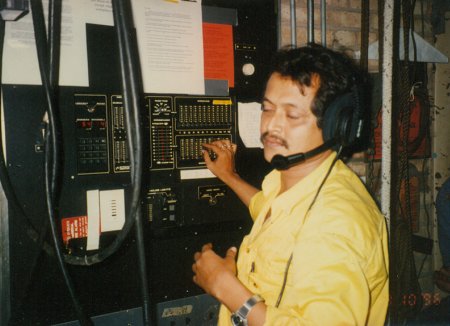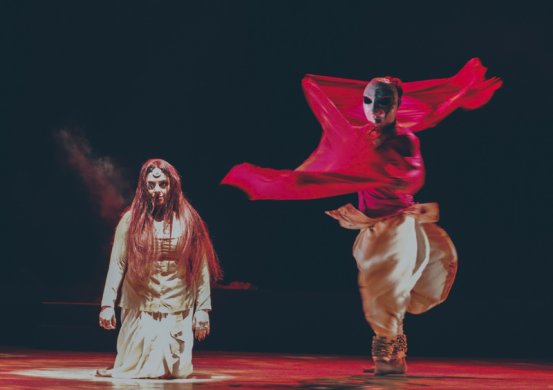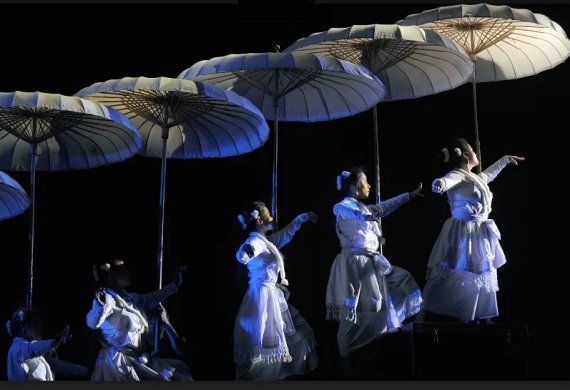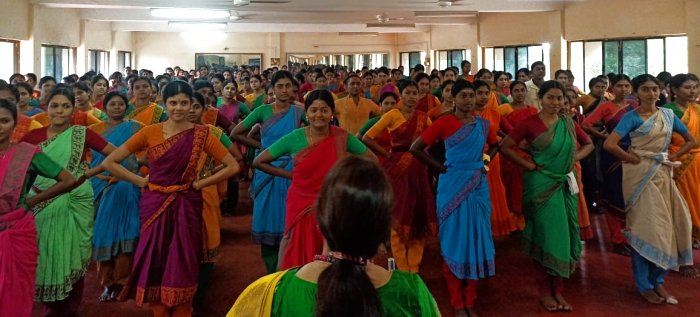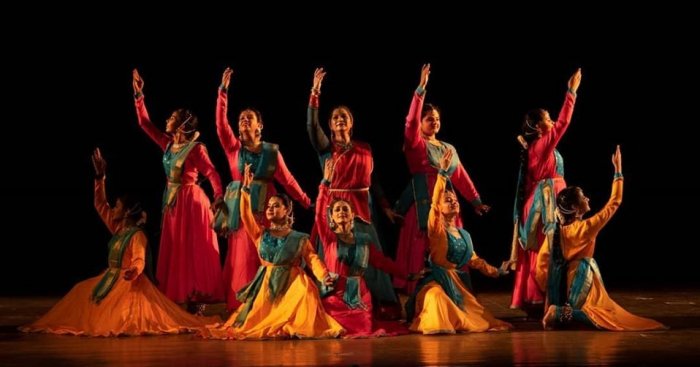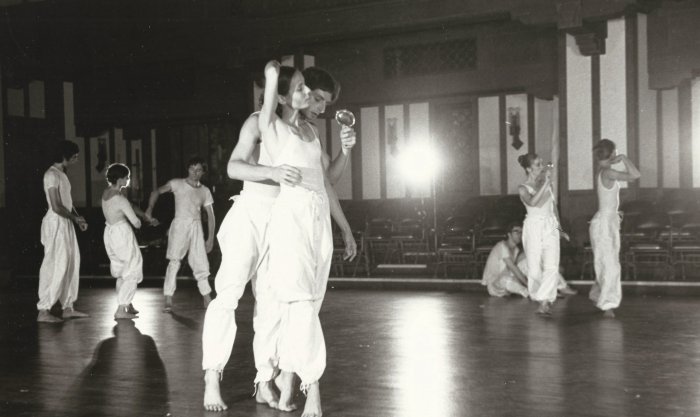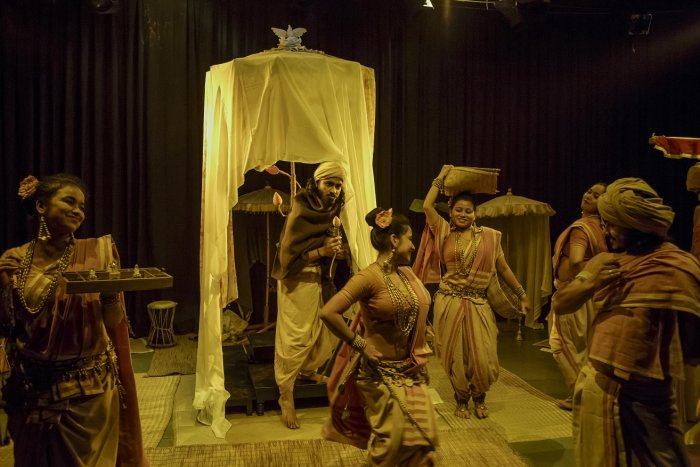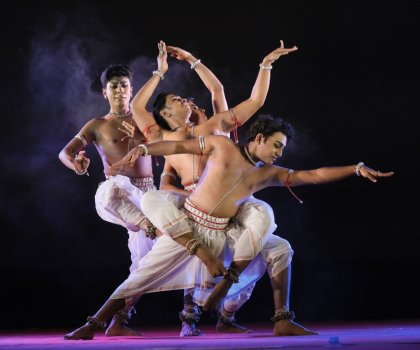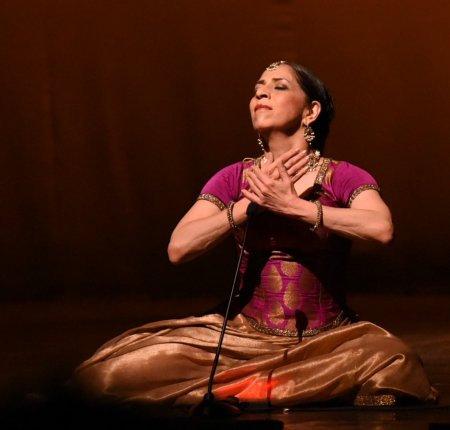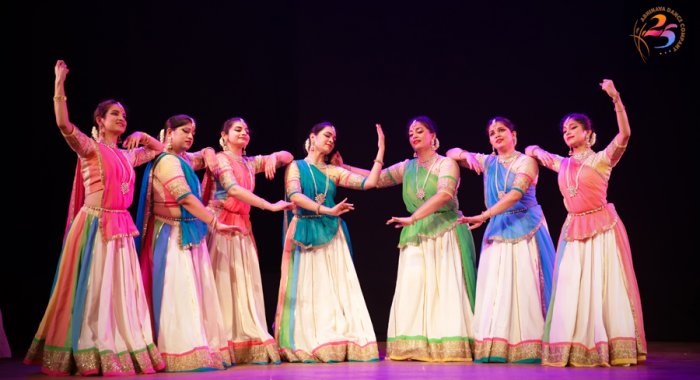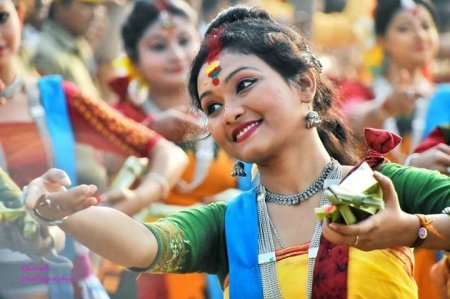It is with deep sorrow that I share with you the news of the untimely demise of a friend, colleague, playwright, stage-light designer and master story teller Jaydev Das at his Cuttack home at 4am early morning on 27th March 2020. He was only 60 years old. Born on 20th April 1960, he was full of vitality and creative ideas till the very end.
Read more in the site
As we are almost all homebound by the need for social distancing and further curtailed by extreme social distancing, social media is buzzing with ideas on how to spend this time. Trevor Noah uses this time to do a version of his hugely popular Daily Show, which he calls "The Daily Social Distancing Show". Priyanka Chopa and Nick Jonas along with other Hollywood/Bollywood couples feed us with a stream of sweet videos of positive messages and pictures and details of how they are spending their time. The virus has been a great equaliser, for star and fans are often doing the same thing.Very popular on both sides of the celebrity divide are experiments in cooking. Some pair the cooking with experiments in drinking. Online Solitaire, Candy Crush, Sudoku and Contract Bridge on the laptop are flourishing. Some serious minded students and some older but eternal students are looking for online courses they could enrol in. Both celebrity and ordinary, if we are to believe Kriti Sanon, are cleaning up their rooms and cupboards!In the glut of options, a fresh idea came from the Union Minister for Women and Child Development, GOI, Smriti Irani. Ms. Irani is rather active on social media, and has an impressive list of followers. She invited all followers on her Twitter account to play 'Twitter Antakshari' with her, and urged them to tweet a line of a song that they like, to get the game going. By all accounts it is a great idea and a really happy way to keep both community and fun alive. But her effort went beyond that and became an effective medium for forwarding the anti Corona message.
Read more in the site
Looking across the board at the performing art treatises ascribed to the late first and early second millennia - such as Abhinaya Darpana by Nandikeswara, Dasarupaka by Dhananjaya, Manasollasa by Someswara, Brihaddesi by Matanga, Nrittaratnavali by Jayasenapati, in that order, among others -- some scholars believed that the Desi (regional) tradition differs from the Marga (classical) in two major ways. One, by putting its emphasis on the style of presentation rather on the context of the composition, and second, by concentrating on the use of more demonstrative, even acrobatic movements. This deems that Marga aspires to be spiritual, transformational or metaphysical experience, whereas Desi is aimed at entertaining. Single codification of dances has tapered down due to ruling kings and temples that dictated what was pure and could be sanctified. But 'regional' is not an antonym to the words 'pure' or 'path'. Desi signifies all aspects of art that are not intentionally created but are rather products of human evolution. It is mostly a naturally-evolved practice, both ritualistic and entertaining in nature. Adhering to this definition, Marga is a consciously created and learnt art. It is only in the later parts of 20th century that their connotations took another turn as 'folk' and 'classical'.
Read more in the site
There is always a buzz about a new play by Ratan Thiyam, the celebrated writer, director, designer, musician, and actor. After he directed Shakespeare's Macbeth three years ago, the latest Lairembigee Eshei, Song of Nymphs in Manipuri, as a closing play at 21st Bharat Rang Mahotsav at Kamani Hall, Delhi, attracted a large crowd to witness the new play.The Chorus Repertory Theatre was established in April 1976 in the valley of the small hill state of Manipur in the easternmost part of India. Since then, Ratan and his company have never looked back, winning awards in international theatre festivals. Renowned for its disciplined performance practice, spectacular aural and visual aesthetics with potent thematic explorations, Ratan's work has placed him in the company of such figures as Suzuki, Brook and Grotowski. To strike a personal note, I have seen from close quarters his direction and training methodology. It has been a rare privilege.
Read more in the site
I had always wanted to visit Sri Lanka. This year, I was fortunate to be invited to Jaffna University to do a workshop and to perform at the Colombo Natyanjali Festival 2020. At the workshop, I was overjoyed to see so many young aspiring dancers. I was so touched because every student had thirst to learn the values of the arts. Several of these students have come out of the trauma of war. I was saddened by listening to many of their personal struggles, those who lost their homes, parents, relatives and friends. How they had struggled on a daily ration of one idli for sustenance and how they studied by the lamplight of a single wick was heart wrenching. Now, dance and the arts are helping them to overcome the agony of the past. When I was encouraged by the teachers to strike conversations with the students, they shed their reservations and many of them opened up and came forward to share their sad experiences. It seemed they saw in me a mother figure.
Read more in the site
It is the irony of life that laments and celebrations go together While a part of Delhi was experiencing tragic riots, 'Dilli Ki Sankriti' celebrating literature, Arts and ideas of Delhi was being held with both 'Dilliwallahs' and immigrants participating, on the greens of the IIC. 'Words in the Garden' saw Sohail Hashmi, S.Y. Quaraishi, Rajeev Sethi and Pavan K. Varma with Ashok Vajpeyi, curator of the three day event moderating, in an exchange of thoughts on the old Delhi of the 1920s and 30s when the city's composite culture, given its vibrant Muslim identity with Sufi culture, also reflected a harmonious blend of religions - demonstrated in Chandni Chowk's Gauri Mandir, Christ Church, Gurudwara, and Ghantaghar all standing cheek-by-jowl, without tensions.
Read more in the site
This essay looks from a 21st CE perspective, the principles of Kakshya Vibhajan as given by Bharata in the Natyashastra, while also trying to identify the principles which trickled into Kathak. The journey of both theatre and dance go hand in hand with the evolution and transformation of the stage - from Bharata's natyamandapam, to the Kathakaars dancing in the chaupal to the modern day auditoriums and stadiums. Through all of this an interesting element that is a unique feature of Kathak is the Gat Palta, which made its way into the Kathak intra-forms approximately 200 years ago, became mainstream during the mid 19th CE and is a versatile element in today's proscenium Kathak. Recently, Dr. Vibha Dadheech published her unique research on 'Gat Nikas' which documented the history, features and uses of the 'Gat Palta'. This essay looks at the 'Gat Palta' from the standpoint of Bharata's Kakshya Vibhajan.
Read more in the site
Moving to New York City in summer 1971, I enrolled at the Merce Cunningham Studio. A few weeks later the Studio held scholarship auditions. I was offered a work-study scholarship, and for the next seven years I took two Cunningham technique classes, six days a week. I also took a daily ballet class at another studio. Four and one-half hours total of training six days a week for seven years developed my stamina and kinesthetic memory.Merce's classes were never the same. We had a few warm-up combinations, such as 'The Exercise on Six' which began each class, but even those exercises could change. During one memorable summer, when Merce taught the Advanced class five days a week for six weeks, he changed the time cycle every few days. For whatever duration of days he decided to continue in that time cycle, Merce composed every warmup, every center and every across-the-floor combination in that chosen time cycle, whether 3, 5, 6, 7, 9, 10, 11 .... Merce also taught a class in choreography. Two concepts which I remember him emphasizing were: 1. carefully construct the beginning and ending of your piece. The audience will remember those sections most clearly and judge your worth by them. 2. Don't show the preparation for changes of directions so transparently that they can be predicted even before you move.
Read more in the site
Established in 2013 by Kathakali exponent and Sanskrit scholar, musician, musicologist, actor, director Piyal Bhattacharya, Chidakasha Kalalaya, Kolkata's aim is to undertake research and practice of Bharata's Natyasastra as prayoga, presentation, reconstructing of Rupakas, which are Rasatmaka, and Uparupakas which are Bhavatmaka. Following various elements of Natyasastra, the recreation of Bhana as Rupaka and Bhanika as Uparupaka by Piyal has further opened up a new chapter in the field of classical theatre, drama and dance-dramas.Devoting his entire life to the study of Natyasastra, the music as referred to in Natyasastra, learning it from classical musicians, within India and abroad in terms of pan Indian approach, recreating instruments as mentioned in Natyasastra, like veena and harp, Piyal has taken a journey which indeed is not an easy one to grasp. It expects of the spectator also to have background of Natyasastra, knowledge of Sanskrit and also Pali, Prakrit and other allied languages - a tall order.In 2013, Piyal staged Bhanika at National School of Drama, New Delhi, which generated interest amongst scholars, directors, dancers, critics. He has been active all these years gathering like-minded actors, dancers who are willing to join him in this journey. With meager financial support but with lot of enthusiasm they have envisioned a form of Marga Natya.
Read more in the site
From time to time, a seer or a visionary has looked afresh at classical dance - not quizzically or with derision - but with a vision to set fresh goals, chalk out new paths, or point out novel directions to take, collaborations to make, charters to seek. So, when a distinguished dancer and choreographer like Malavika Sarukkai sets up a trust like 'Kalavaahini' with the purpose of "fostering excellence in classical dance and the critical heritage of the land it represents", and sets up one of its objectives as "identifying and nurturing committed dancers of the next generation who differentiate themselves and work towards raising standards in dance presentation so that the Trust could aim at keeping the intrinsic flow of tradition, vibrant and salient and also give wider exposure to the participating dancers", one has to sit up and take notice.Similarly, when a performer / teacher par excellence, and a distinguished public persona like Dr. Sonal Mansingh comes for holding a four-day workshop "not only to teach about the gradations in dance, but also dwell upon the finer nuances of the art and lead the participants into her famed choreography, Sunaina, which refers to a woman's beautiful eyes, analogies of which are drawn from Odiya and Sanskrit poetry," one stands to hugely benefit from the aesthetic effort. In addition, when this is accompanied by a heart-searching by a veteran dancer like Sutapa Talukdar, "Today's generation lacks the knowledge of what makes good dance. The soul of dance seems to be missing. There is an essential difference between dance and movement. Not all movement is dance. This knowledge is lost from the consciousness of the learners. Therefore, as artists, they are flawed. It is imperative that the younger generation understand nuances of what makes a good artist. And who better to teach that than the artist who is a living, breathing example of what a true artist is!" And when the effort is buttressed by Sonal's path-breaking innovation like Natya Katha, one cannot but stand to gain a revealing insight into arts as a whole from her synoptic vision.
Read more in the site
Just a few days ago, newspapers in India ran a depressing headline. "Court has deferred the matter as the mercy petition of one of the convicts (of the Delhi gangrape case), is pending before the President of India." And yet again, our judiciary system has let us down. The irony here is that this news breaks out in the same month as International Women's Day, a day we commemorate women.The women of India probably let out a collective sigh of despair, knowing fully well how this game will play out. Courts do their administrative dance. Governments dither. Social activists who once shouted hoarse are now exhausted. The newspapers move on to juicier headlines. And the people of India get on with their business. Life goes on.The dead don't speak up for themselves. It is the living who make all the noise. Thus, while Nirbhaya's soul hangs in a void, we the people of India simply shrug and say, "It's like this only!"Now, you'd ask me, "How is this related to dance?" That's easy. Dance is a mode of expression. Dance speaks the voice of the soul. Dance is how you connect the abstract and the real worlds. If you look at the Indian classical dance sphere, most dancers are women. In fact, it is probably one of the few professions where women outnumber men. Though dance was traditionally a male bastion, today women have taken to dance like fish to water. Since most dancers are predominantly women, should we not introspect on how dance, a powerful mode of expression has played a role in the upliftment of women?
Read more in the site
Some time ago, I was at a workshop and performance by the Aditi Mangaldas Dance Company - Drishtikon Dance Foundation. Between the workshop and the performance, Kathak veteran and contemporary choreographer Aditi Mangaldas sat down for an interview with Saattvic, a young actor, classical tabla player and Kathak dancer. Aditi is known as much for her abstract contemporary-dance-based-on-Kathak choreographies, featuring powerful, demanding movements, as for her mastery over technical Kathak and bhava and her evocative use of the classical idiom. The conversation was about how the renowned Kathak exponent develops her productions and what triggers these ideas.Aditi started by elaborating on how she began questioning and experimenting with the traditional Kathak idiom."I started dancing at the age of five with my guru Kumudini Lakhia. My influences were her way of thinking and my family, which happened to be very liberal. We were encouraged to question, debate, agree, disagree... Kumiben often said that whatever was written, was written with reference to context. Question everything, she said.
Read more in the site
Kathak dancers Nirupama and Rajendra, the husband and wife team are well known and have been active on the scene for more than 25 years. They celebrated silver jubilee of their institution for two days on 14th and 15th February at Chowdiah Hall, Bangalore.
Read more in the site
The respectable Bengali families started appreciating dance as an art with the initiative of Rabindranath Tagore in Santiniketan. Rabindranath's exposure to one of the most lyrical dance styles of India, the Manipuri dance, in Tripura brought about a dance-renaissance in the Bengali society in the early 20th century. Though he first witnessed Manipuri dance in the Vasantotsava in Agartala in 1899, it took him almost 20 years i.e. 1919 to introduce the dance in his ashram in Santiniketan. This only establishes the fact that Manipuri dance as an art form had appealed to Rabindranath in such an intense manner in 1899 that even after 20 years, he felt the necessity for introduction of dance among his ashramites.
Read more in the site
Artists are the timekeepers of humanity
How else will we know about the civilisations that came before us?
So fret not
We will still be here, working,
When the tides shift and you’re nowhere to be found
Except in the list of history’s tyrants
Good luck trying to erase us- Boston based dance artiste Mesma Belsare in response to US President Trump’s attempt to disband the National Endowment of the Arts.I write this from Melbourne, Australia where images of horrifying violence from New Delhi streets are flooding Facebook and Twitter. Again I ask myself, what is the purpose of art at times of extreme stress? Still we continue… hope seems distant but we continue...So.... did Cupid’s arrows strike last month? Did anyone feel the flutter or renew their vows? SRINGARA RASA makes the world go round they say but during these times of global anxiety, what we need is a new avatar of Cupid/Manmada. That naked cherub and the marauding Kama-terrorist is too banal for these cynical times of diverse loving. Today, love needs VALIUM and XANAX. And also an expiry date!How many danced in the NATYANJALI circuit in Tamilnadu? How many allowed themselves to be hypnotised by Sadguru Jaggi Vasudev as he executed his ‘Trance Dance” on Sivaratri at his ISHA YOGA ASHRAM near Coimbatore?And how about the gorgeous venue of the Khajuraho dance festival? How many got to show off against the beautiful backdrops?How many of you marched and danced on the streets during Mardi Gras parades in cities around the world? Did you throw caution to the winds and abandon yourselves to the DIONYSIAN spirit?And how many Desis will prepare to dance in duplicate copies of Rio’s CARNIVAL which is dotting several Indian cities this year?
Read on in the site
